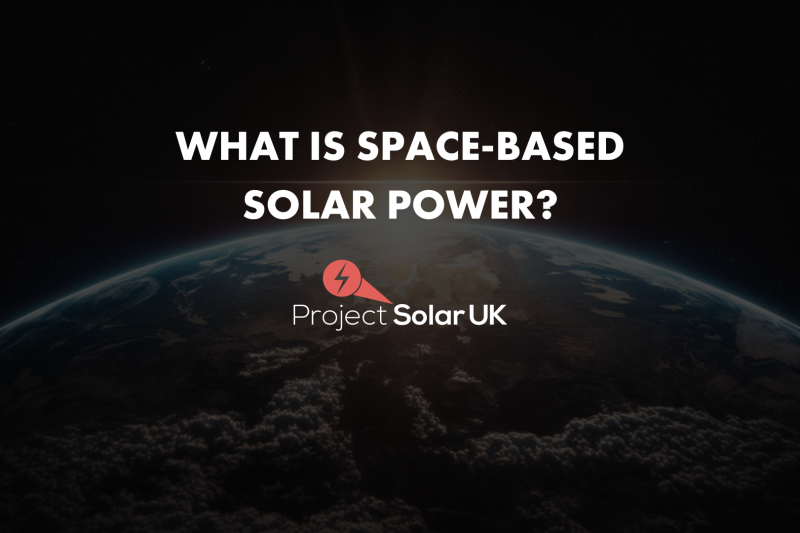Space-based solar power (SBSP) is a revolutionary concept in renewable energy technology.
By harnessing the sun’s energy, free from the Earth’s atmosphere and day-night cycle, SBSP promises an almost constant energy supply. Understanding the nuances of this technology will become important as we move towards a greener future.
What is SBSP?
Theoretically, SBSP technology aims to tap into the unlimited solar radiation in space. Panels can receive more intense sunlight than on Earth, and without an atmosphere to scatter or absorb the sun’s rays, they operate at higher efficiencies.
The stationary satellites which host these panels remain in a fixed position relative to the surface of Earth. Their stable position means they can face the sun constantly and collect solar energy 24 hours a day, seven days a week.
How does space-based solar power work?
Once the solar energy is collected, it is converted into either microwave or laser form for transmission. Conversion is crucial as it involves changing the solar energy into a form that can be safely beamed over the vast distances between the satellite and Earth’s surface.
-
Microwave transmission
The more traditional method, where collected solar energy is converted into microwaves using a device called a ‘magnetron’ or a ‘gyrotron’.
Microwaves are favourable due to their lesser susceptibility to atmospheric conditions, which might disrupt the transmission of solar energy.
-
Laser transmission
Although less common, laser transmission involves converting solar energy into a coherent beam of light photons. This method is potentially more efficient than microwave transmission and can reduce energy loss over long distances.
What are the benefits of space-based solar power?
-
Continuous energy supply
One of the most significant benefits of SBSP is its ability to collect solar energy irrespective of the time of day or weather conditions. Satellites in stationary orbit have an almost constant line of sight to the sun, resulting in an uninterrupted energy capture.
-
Scalability potential
The amount of solar energy available in space is basically limitless. SBSP has the capacity to deploy multiple solar satellites and can be scaled up to provide a significant share of humanity’s energy needs.
The potential energy yield from space-based collectors offers a scalable solution as global energy demands continue to grow.
-
Reduction in greenhouse gas emissions
A SBSP system’s operation does not produce greenhouse gas emissions, which are a major contributor to climate change. By providing a cleaner alternative to fossil fuels, SBSP can significantly reduce pollution and help nations meet their carbon reduction targets.
-
Minimal land use
Unlike on-land solar farms, SBSP does not require large tracts of land for installation. SBSP could minimise the impact on natural landscapes and biodiversity, as solar panels can be deployed in space without disturbing ecosystems.
What are the challenges of space-based solar power?
-
Deployment challenges
Launching materials into space is extremely expensive. Building and deploying large-scale solar panel systems into orbit requires massive investments and poses many logistical challenges. Plus, the current capacity of rockets and the physical stresses of launch make transporting delicate equipment complex.
-
Energy transmission
The conversion of solar energy into microwaves or laser beams requires technologies that operate at very high efficiencies.
Current conversion technologies, such as solar PV cells used with microwave transmitters, achieve around 40-50% efficiency. Improving this efficiency is vital for the practical implementation of SBSP, as losses affect the system’s performance.
-
Regulatory challenges
The transmission frequencies used for SBSP, whether microwave or laser, need to be regulated to avoid interference with other satellite communications.
Navigating the international regulatory landscape for SBSP transmission is a complex issue that requires international cooperation.
-
Environmental impact
As more structures are placed in orbit, the risk of space debris increases; this could lead to collisions that create even more debris and threaten the integrity of SBSP systems.
Developing strategies to minimise debris is essential for the long-term viability of space-based solar power projects.
Could SBSP be the future of global energy?
There’s no doubt that SBSP holds transformative potential for meeting the world’s energy demands. As of 2024, it is currently in the research and development phase.
While the concept is proven in principle, it will require significant advancements in space technology, energy transmission, and infrastructural development to become practical.
Join the solar takeover!
As scientists worldwide work to make SBSP a possibility, why not make a difference here on Earth? Installing solar panels on your home or business is a great way to contribute to the fight against climate change.
To find out more about what you can do, contact us.

